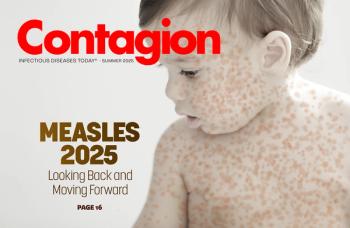
- August 2019
- Volume 4
- Issue 4
Maximize Contact and Minimize Isolation

Optimizing the relationship between infection prevention and antimicrobial stewardship.
Hospitals and other acute patient care facilities are an important part of the infrastructure of any community. Patients seek care from these institutions to improve health. The risk of acquiring an infection within these institutions represents an unfortunate reality for many.
IMPACT OF HOSPITAL-ACQUIRED INFECTIONS
The results of a prevalence study conducted by the US Centers for Disease Control and Prevention (CDC) revealed that an esti­mated 687,000 hospital-acquired infections (HAIs) occurred in 2015, with 72,000 resulting in death during the hospital­ization.1 Estimations of the overall use of antibiotics in acute care facilities have remained fairly stable over the last several years. Roughly 50% of patients admitted to an acute care hospital will receive at least 1 dose of an antibiotic, and 30% of antibiotic days of therapy may be inappropriate.2,3
Antimicrobial utilization and HAI development converge around the potential for acquisition of an HAI with a multi­drug-resistant organism (MDRO). Increased antibiotic utili­zation, even on 1 patient care unit within a facility, places selective pressures on bacterial populations, subsequently changing the bacterial isolates and antimicrobial suscepti­bility patterns observed within the overall population and care setting.4,5 This reality is troublesome in acute care hospitals where overuse or inappropriate use of antibiotics may adversely affect the susceptibility patterns of organisms acquired as HAIs.
The concern for MDRO acquisition in health care settings is illustrated within various national treatment guideline recommendations that indicate that empiric broad-spec­trum antimicrobial therapy covering methicillin-resistant Staphylococcus aureus and multidrug-resistant gram-negative bacilli, including Pseudomonas aeruginosa, for various HAIs.6,7 Infections with antimicrobial-resistant organisms is associated with increased cost, morbidity, mortality, and length of stay.8
To combat HAIs, regulatory measures and surveil­lance mechanisms have been developed. In 1976, the Joint Commission on Accreditation of Healthcare Organizations instituted the requirement that hospitals have an infection control program in place. In the mid-1980s, the CDC estab­lished a surveillance system for reporting HAIs called the National Nosocomial Infection Study (now known as the National Healthcare Safety Network [NHSN]). NHSN moni­tors and benchmarks HAI rates on a national level.
ORIGINS OF INFECTION PREVENTION AND ANTIMICROBIAL STEWARDSHIP
Elements of antimicrobial stewardship (ASP) have been in effect across the globe for decades, but the implementation of ASP efforts in the United States began to gain steam in 2007 with the publication of the Infectious Diseases Society of America (IDSA) and Society for Healthcare Epidemiology of America (SHEA) guideline on the implementation of ASP.9 In 2014, the CDC released its core elements of ASP, and the United States President’s Council of Advisors on Science and Technology (PCAST) released a report detailing antimicrobial resistance as a major threat to public health in the United States.10,11 The PCAST report led to the establishment of a national action plan for combating antimicrobial resistance in 2015, a revised IDSA/SHEA guideline on ASP practices in 2016, and drafting and implementation of regulatory standards by CMS and The Joint Commission pertaining to ASP in 2017.12-14
NHSN now has a voluntary reporting mechanism for anti­microbial utilization rates, allowing hospitals to benchmark their antimicrobial utilization. Given the parallel regula­tory measures, antimicrobial resistance targets, and overlap in targeted disease states, such as Clostridioides difficile infection and surgical site infections, ASP and infection prevention programs (IPPs) were primed for partnership. Optimization of this relationship and its associated multi­disciplinary collaboration on targeted initiatives is likely to produce positive effects beyond what either department may accomplish in isolation.
EVIDENCE OF DEPARTMENTAL SYNERGY
The most important role of an IPP is to prevent the HAIs that require treatment with antibiotics. This reduces selective pressure of antimicrobials, which can result in the develop­ment of MDROs and C diff infection. Some of the most basic infection prevention measures reduce the incidence of HAIs—hand hygiene, environmental cleaning, and contact precau­tions—which are all designed to break the chain of infection transmission. In addition to these basic infection prevention practices, IPPs have partnered with ASPs and clinical labora­tories to educate providers regarding appropriate diagnostic testing stewardship, such as ordering urine cultures only when a patient’s symptoms indicate evidence of infection and using best practices for the collection of blood cultures that mini­mize the risk of contamination of specimens.15,16
This is mutually beneficial because it impacts the tracking targets of both programs (ie, catheter-associated urinary tract infection and central line—associated blood stream infection rates for IPPs and inappropriate antimicrobial utilization for ASP programs). With the association of broad-spectrum antibiotic use and the development of C diff infection, HAIs may benefit from the collaboration of IPPs and ASPs. The rate of inappropriate systemic antimicrobial prescribing, even after an initial C diff episode, may still be suboptimal, and, furthermore, inappropriate systemic antimicrobial utilization after a C diff episode has been associated with an increased rate of recurrence.17 Implementation of multi­disciplinary programs, including both infection prevention and ASP, that target a reduction in hospital-onset C diff (HO-CDI) rates, have produced benefits at both the institu­tional and regional levels.18,19 Additionally, C diff guidelines in Europe and the United States emphasize the importance of infection prevention and ASP measures in the preven­tion of HO-CDI.20,21 The need for ASP and IPP collaboration has also been demonstrated by the interplay between the diagnosis and management of other disease states, such as urinary tract infections, and C diff. A recent report from a retrospective cohort study in nursing homes demonstrated that increased rates of urine culture obtainment was asso­ciated with increased rates of antimicrobial utilization and thereby increased rates of C diff.22 This study highlights the complexities present within the fields of infection preven­tion and antimicrobial stewardship as they relate across the continuum and demonstrates their inseparable nature within syndrome specific care.
Most recently, the rise of Candida auris as a pathogenic threat has further highlighted the importance and complex interplay between ASPs and IPPs. As of April 30, 2019, this Candida spp. has been associated with 654 clinical cases across 12 states and been implicated in HAIs.23 Because it may be spread through contact with contaminated surfaces, equipment, or persons, appropriate isolation and infection prevention is critical to reduce the spread of this organism. The relationship between C auris infection and ASP is 2-fold. First, one of the risk factors for development of infection with C auris is receipt of broad-spectrum antibiotics or anti­fungals. Second, this organism is known to have widespread resistance to azole antifungals, strains resistant to multiple antifungal classes have been observed, and resistance may develop rapidly during therapy. Thus, empiric therapy with an echinocandin and close follow-up are necessary. Appropriate isolation and infection prevention measures as well as ASP and therapy optimization will be critical in the containment and prevention of HAIs due to C auris.24
Historically speaking, ASPs have largely focused their efforts on the primary stewardship strategies of prospective audit with intervention and feedback or formulary restriction. As ASPs seek to optimize antimicrobial therapy on an institu­tional level they may benefit from taking note of the long practiced IPP strategy of targeting syndrome specific goals. Mediwala et al recently showed that a prospective audit and feedback intervention strategy targeting carbapenem and piperacillin/tazobactam utilization failed to demonstrate a significant reduction in usage; however, when a syndrome specific strategy was employed targeting these agents in bloodstream and intra-abdominal infec­tions statistically significant reductions in utiliza­tion rates were observed.25
CONCLUSIONS
The CDC’s core elements guidance document for hospital ASPs recommends infection prevention­ists as key support, given their skill set in auditing, analyzing, and reporting data as well as their knowledge of tracking HAIs and educating health care staff.10 With an infrastructure that includes the CDC’s 7 core elements plus the diagnostic capabilities and guidance of the clinical microbiology labo­ratory, any health care facility can develop an effective ASP program; however, optimizing the efficiency and maximizing the outcomes of an ASP will be more effectively accomplished through the integration of infection preventionists into ASP activities.26 Daily communication amongst these disciplines, sharing their unique perspectives, and focusing on the care of patients creates a synergy that can have important effects at both the patient level, through improvements to an individual patient’s care or HAI risk, and a facility or region, through reductions in HAI rates.
In our 400-bed community hospital, the ASP and IPP are located within the same department. Often the ASP will iden­tify patients in need of infection prevention during their daily prospective audits, and the IPP will identify opportunity for antimicrobial or diagnostic testing optimization during their daily census review. The physical proximity of the 2 programs has increasingly emphasized the subject matter overlap and, moreover, optimized the daily workflow and longitudinal outcomes of both programs. The important work of preventing HAIs and misuse of antimicrobials through stewardship activ­ities are inextricably linked. The realization of their interde­pendence and activities to facilitate coordination between these 2 programs is sure to contribute to patient safety.
Stevens is an antimicrobial stewardship/infectious diseases pharmacist at Mayo Clinic in Rochester, Minnesota. He received his PharmD from the University of Montana in Missoula, and completed his PGY1 pharmacy practice residency at Alaska Native Medical Center in Anchorage. *He is an active member of the Society of Infectious Diseases Pharmacists.Barnard is a data integrity infection preventionist at Providence Alaska Medical Center with more than 30 years of experience in the field. She has served as a leader at the national level with the Association for Professionals in Infection Control and Epidemiology (APIC), presented to numerous audiences and published on various infection prevention and control topics. Certified in infection control since 1985, she is also an APIC fellow.
References:
- CDC. Healthcare-associated infections: data portal. CDC website. cdc.gov/hai/data/portal/index.html. Published March 19, 2018. Accessed April 10, 2019.
- Baggs J, Fridkin SK, Pollack LA, Srinivasan A, Jernigan JA. Estimating national trends in inpatient antibiotic use among US hospitals from 2006 to 2012. JAMA Intern Med. 2016;176(11):1639-1648. doi: 10.1001/jamainternmed.2016.5651.
- Hecker MT, Aron DC, Patel NP, Lehmann MK, Donskey CJ. Unnecessary use of antimicrobials in hospitalized patients: current patterns of misuse with an emphasis on the antianaerobic spectrum of activitiy. Arch Intern Med. 2003;163(8):972-978. doi: 10.1001/archinte.163.8.972.
- Laxminarayan R, Duse A, Wattal C, et al. Antibiotic resistance—the need for global solutions. Lancet Infect Dis. 2013;13(12):1057-1098. doi: 10.1016/S1473-3099(13)70318-9.
- Mulvey MR, Simor AE. Antimicrobial resistance in hospitals: how concerned should we be? CMAJ. 2009;180(4):408-415. doi: 10.1503/cmaj.080239.
- Kalil AC, Metersky ML, Klompas M, et al. Management of adults with hospital-acquired and ventilator associated pneumonia: 2016 clinical practice guidelines by the Infectious Diseases Society of America and the American Thoracic Society. Clin Infect Dis. 2016;63(5):e61-e111. doi: 10.1093/cid/ciw353.
- Tunkel AR, Hasbun R, Bhimraj A, et al. 2017 Infectious Diseases Society of America’s clinical practice guidelines for healthcare-associated ventriculitis and meningitis [published online February 14, 2017]. Clin Infect Dis. doi: 10.1093/cid/ciw861.
- Cosgrove SE. The relationship between antimicrobial resistance and patient outcomes: mortality, length of stay, and health care costs. Clin Infect Dis. 2006;42(suppl 2):S82-S89. doi: 10.1086/499406.
- Dellit TH, Owens RC, McGowan JE, et al; Infectious Diseases Society of America; Society for Healthcare Epidemiology of America.. Infectious Diseases Society of America and the Society for Healthcare Epidemiology of America guidelines for developing an institutional program to enhance antimicrobial stewardship. Clin Infect Dis. 2007;44(2):159-177. doi: 10.1086/510393.
- CDC. Antibiotic prescribing and use in hospitals and long-term care. Core elements of hospital antibiotic stewardship programs. CDC website. cdc.gov/antibiotic-use/healthcare/implementation/core-elements.html. Accessed June 11, 2019.
- US Department of Health and Human Services. Presidential Advisory Council on Combating Antibiotic Resistant Bacteria (PACCARB). HHS website. hhs.gov/ash/advisory-committees/paccarb/index.html. Accessed June 11, 2019.
- CDC. Antibiotic/antimicrobial resistance (AR/AMR): U.S. national action plan for combating antibiotic-resistant bacteria (national action plan). CDC website. cdc.gov/drugresistance/us-activities/national-action-plan.html. Published March 2015. Accessed June 11, 2019.
- Barlam TF, Cosgrove SE, Abbo LM, et al. Implementing an antibiotic stewardship program: guidelines by the Infectious Diseases Society of America and the Society for Healthcare Epidemiology of America. Clin Infect Dis. 2016;62(10):e51-e77. doi: 10.1093/cid/ciw118.
- The Joint Commission. New antimicrobial stewardship standard. Jt Comm Perspect. 2016 Jul;36(7):1, 3-4, 8.
- Lin G, Knowlson S, Nguyen H, et al. Urine test stewardship for catheterized patients in the critical care setting; Provider perceptions and impact of electronic order set interventions [published online May 22, 2019]. Am J Infec Ctrl. doi: 10.1016/j.ajic.2019.04.005.
- Garcia RA, Spitzer ED, Beaudry J, Beck C, et al. Multidisciplinary team review of best practices for collection and handling of blood cultures to determine effective interventions for increasing the yield of true-positive bacteremias, reducing contamination, and eliminating false-positive central line-associated bloodstream infections. Am J Infec Control. 2015;43(11):1222-1237. doi: 10.1016/j.ajic.2015.06.030.
- Watson RL, Graber CJ. Lack of improvement in antimicrobial prescribing after a diagnosis of Clostridium difficile and impact on recurrence. Am J Infect Control. 2018;46(12):1370-1374. doi: 10.1016/j.ajic.2018.04.213.
- Rizzo KR, Yi SH, Garcia EP, Zahn M, Epson E. reduction in Clostridium difficile infection rates following a multifacility prevention initiative in Orange County, California: a controlled interrupted time series evaluation. Infect Control Hosp Epidemiol. 2019;1-8. doi: 10.1017/ice.2019.135.
- Christensen AB, Martin DW, Anderson MM, et al. Diagnostic stewardship of C. difficile testing: a quasi-experimental antimicrobial stewardship study. Infect Control Hosp Epidemiol. 2019;40(3):269-275. doi: 10.1017/ice.2018.336.
- Tschudin-Sutter S, Kuijper EJ, Durovic A, et al. Guidance document for prevention of Clostridium difficile infection in acute healthcare settings. Clin Microbiol Infect. 2017;24(10):1051-1054. doi: 10.1016/j.cmi.2018.02.020.
- McDonald LC, Gerding DN, Johnson S, et al. Clinical practice guidelines for Clostridium difficile infection in adults and children: 2017 update by the Infectious Diseases Society of America (IDSA) and Society for Healthcare Epidemiology of America (SHEA). Clin Infect Dis. 2018;66(7):e1-e48. doi: 10.1093/cid/cix1085.
- Brown KA, Daneman N, Schwartz KL. The urine culturing cascade: variation in nursing home urine culturing and association with antibiotic use and C. difficile infection [published online June 14, 2019]. Clin Infect Dis. doi: 10.1093/cid/ciz482.
- CDC. Candida auris: tracking Candida auris. CDC website. cdc.gov/fungal/candida-auris/tracking-c-auris.html. Updated June 2019. Accessed June 12, 2019.
- CDC. Candida auris: information for laboratorians and health professionals. CDC website. cdc.gov/fungal/candida-auris/health-professionals.html. Updated December 2018. Accessed June 12, 2019.
- Mediwala KN, Kohn JE, Bookstaver PB, et al. Syndrome-specific versus prospective audit and feedback interventions for reducing use of broad-spectrum antimicrobial agents [published online June 18, 2019]. Am J Infect Control. doi: 10.1016/j.ajic.2019.04.175.
- Manning ML, Septimus EJ, Dodss Ashley ES, et al. Antimicrobial stewardship and infection prevention — leveraging the synergy: a position paper update. Am J Infec Ctrl. 2018;46(4):364-368. doi: 10.1016/j.ajic.2018.01.001.
Articles in this issue
over 6 years ago
Two Allergies or Cross-Reactive?over 6 years ago
2019: Measles Outbreaks in the United Statesover 6 years ago
Doravirine: Researchers DRIVE for a Drug Ahead of Its ClassNewsletter
Stay ahead of emerging infectious disease threats with expert insights and breaking research. Subscribe now to get updates delivered straight to your inbox.































































































































































































































































































































